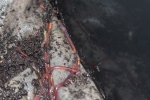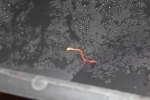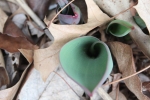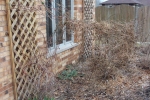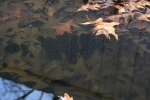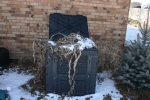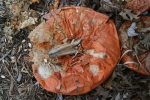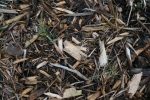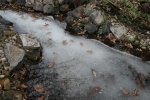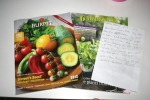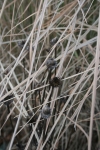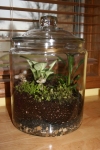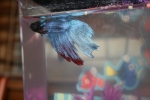-

-
Coconut Coir Stew
-

-
Processed Brussel Sprouts
-

-
The First Tray ready for Hermans
-

-
The Hermans in their new home!
-
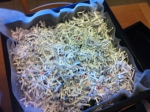
-
First tray with shredded paper
-

-
completely assembled – one tray in place
-

-
Just after the phone call to the nephew
-
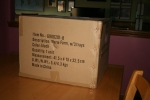
-
the BOX!! the BOX!! the BOX!!!
-

-
“Live Product” – I felt so EXOTIC!!
-

-
Worms on the right in the newspaper
-

-
Bag o’ worms
-
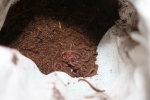
-
Worms in their temporary home
-

-
One of the rebels, trying to escape
The worms were expected to arrive either Wednesday or Thursday. As the weather has been cold, I was hoping against hope that I’d be home when the postman arrived so the poor things wouldn’t have to sit out in the cold. The last thing I wanted was a box of frozen little worm carcasses on my front porch.
On Wednesday, I heard the familiar starting and stopping of the postal truck and looked out of (okay, actually ran to) the front window. When the postman stopped the truck, got out of the seat and began to rummage in the backseat, I was practically hopping up and down. I opened the front door as he turned with a big brown box in hand and started up the drive. He saw me on the porch and smiled. “This says ‘Live Product’ here,” he said.
“It’s worms!” I replied. “For indoor composting.” He lifted his eyebrows in a most compassionate way – perhaps thinking of all the times I’ve walked down to get the mail from him in purple latex gloves and silly hat. “Ahhhh,” he said. “You have fun with that.”
While I was indeed simply dying to open that box, postmarked from Uncle Jim’s Worm Farm, at that moment, I had projects to finish. If I opened it, that would be the end of that, so the box was placed on the kitchen table (don’t tell Tony- he’d never eat from that table again). At 4:30, I could stand it no longer. Scissors cut through tape, out came cardboard spacers and there, atop more brown plastic trays, wrapped in newspapers, was a cloth bag, damp and slightly squirmy.
I tugged on the drawstring and looked in. Yep, worms. Red and wriggling, looking a little dry and pathetic. Kind of weird and kind of cool all at the same time. I felt committed to their well-being immediately.
I unpacked the Worm Factory. A few wild adventurers had crept out of the bag during transit; those were found randomly between box and tray, jerking and flailing in the now-bright light. I was reminded of Earthworm in “James and the Giant Peach” – anthropomorphosizing this soon is going to mean trouble. A welcome sheet recommended adding about a 1/2 cup of water into the cloth worm bag immediately as “the worms probably need a drink.” I gently poured that in and set the bag on one of the plastic trays.
The assembly and farming instructions were printed on a slick white sheet in black ink and there were typos on the front that made me sigh in disappointment. The booklet told me I was a courageous, reliable, committed and intelligent individual, embarking on a quest both daring and challenging, sustaining the health of our beloved planet. Well, my goodness.
My sense of self-worth now happily inflated, I found all the parts as indicated, installed the faucet (to drain that worm pee, er, tea) in the collection bin and stacked all the other three trays, like dish pans with colanders in the bottoms, just as shown in the illustration. The lid fit snugly on the top tray.
And then things skidded to a halt. Included in the package were two Tyvek-like sheets – but nothing in the instructions explained what to do with them. The main illustration showed the two lower trays full of material: shredded paper, veggie peels and the like. But the instructions were incredibly vague, with sentences such as “Put the lid on the second trays.” Well, which one is the second tray? (the typos were making me nuts) Why were there “remaining unfilled trays” – plural – if you’re already using two of them? And citrus (orange peels) is a death knell for the worms? “Always feed worms from the top tray” made no sense as, in the illustration, the materials are clearly in the lower trays.
Since I am a fervent believer in the power of the 800 number, I dialed up Uncle Jim. And found out that the Worm Farm had closed just 15 minutes before. Internet searches revealed dozens of how-to videos to assemble the farm itself, but none of the getting-the-worms-situated-and-chewing information seemed to match Uncle Jim’s instructions.
Well, the worms were watered, squirming happily (or at least squirming) in a bag of damp peat. Could they last until Thursday morning? I thought yes. I packed the bag into one of the trays, stacked it all up and put it on the basement stairs landing and turned off the light.
There were no good night kisses and the kitchen table was scrubbed clean.
The next morning, I called Uncle Jim’s and spoke to (I would suppose) one of the nephews. He initially seemed a little put out at my questions, but explained very clearly (unlike the instructions) that the trays are added one at a time. The Tyvek can be used to line the tray – or not, as you prefer. The included bag of coconut coir should be mixed with enough water to make it almost soupy, but not quite (how about stew-y?), and laid on the bottom of the tray. This advice was mentioned absolutely nowhere in the booklet. Foodstuffs should be layered in (no citrus, not under any circumstances ever), a little shredded paper, “whatever you like” (except citrus, dairy, meat or oil) and then the worms dumped in and the lid closed. In 4 weeks, said the nephew, we should put more peelings and eggshells and shredded paper in a second tray. When we remove the lid from the first tray, we should see a pile of worm poop, er, castings at that point. That’s when we should put that second tray on top, replace the lid, and wait another week for the worms to migrate out of their (and I truly loved this) “byproducts.” After another few weeks, we’ll dump the castings in the bottom tray in the garden and add another materials-filled tray to the top, rotating these like a ferris wheel, with the most casting-rich tray on the bottom and the newest food at the top.
Never include citrus.
The nephew said the cycle will go faster and faster as the worms reproduce to fill the space, but never to overpopulate (that’s smarter than humans). He also mentioned that I shouldn’t include citrus peels or rinds. (I get it, I get it, I get it.)
I hung up the phone and went through the “Other Useful Hints” in the booklet again. With the nephew’s clarification, the hints made more sense. It was recommended that materials be cut into small pieces, even run through a food processor. In for a penny, in for a pound, I hauled out the Oster and shredded the old brussel sprouts and the mealy apples. I promised myself this would not become a regular custom.
I dumped the coconut coir into a big steel bowl and added water. The earthy smell of spring wafted from the bowl and I took a deep breath. And added more water. And more water. And more water – this stuff just sucks it up. Finally, there was enough to hand mix it into a sludge, seemingly exactly what the nephew described. That went on top of that sheet of Tyvek in the bottom tray. On top of that went the sprouts and apples and old onions (will the worms have bad breath? will they still be able to mate with this troublesome halitosis? or have I doomed this colony to a Shaker-like demise?). On top of that, shredded paper and a good drink of water. I did not add any orange peels.
The worms were then released from the bag, dumped rather unceremoniously into the center of this tray. I fretted about water content, so added another 1/2 cup. The shredded paper seemed to soak it up. The worms, every one of them named Herman, felt the wind in their hair and wiggled and squirmed in celebration of their freedom. I wondered if there were truly 1,000 and if there is someone at Uncle Jim’s patiently counting 1,000 worms into cloth bags. The cloth bag, seemingly completely empty, went outside the house nevertheless, placed on the backyard hose reel.
The lid went on the farm and the whole kit and kaboodle went to its permanent home on the landing of the basement stairs, two empty trays waiting their turn. All The Hermans can get to work now; the many factors for eating and pooping are perfectly in place. The temperature is perfect there, they have a very full meal in front of them and there is no citrus.
I shut the door to the basement and felt courageous, reliable, committed and intelligent. I felt like I’m doing a small part to make the planet a better place. I felt this year’s tomatoes will be juicier, the cucumbers bigger, the coneflowers taller and my impatiens bushier.
I felt the need to scrub the kitchen table again.



